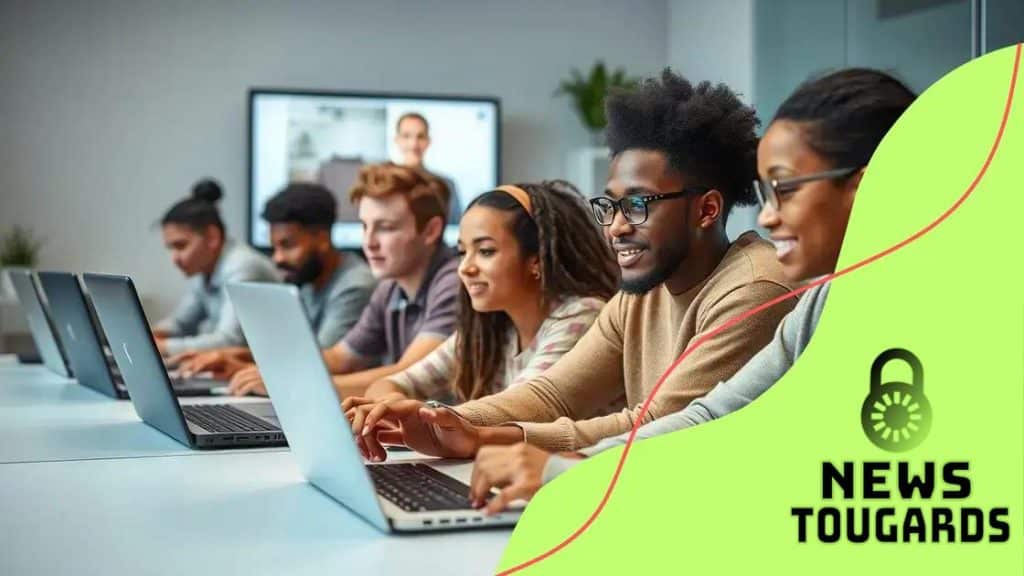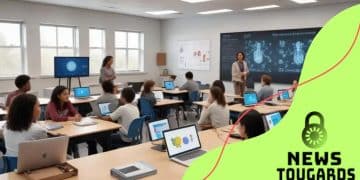How virtual classrooms are shaping modern education

Virtual classrooms are transforming modern education by offering flexibility, enhanced access to resources, and fostering collaboration, while leveraging technology like AI and VR for engaging and personalized learning experiences.
How virtual classrooms are shaping modern education signifies a massive shift in how we approach learning today. They offer unprecedented flexibility for both students and educators, inviting us to rethink traditional teaching methods. Have you ever wondered how this impacts your daily learning?
The evolution of virtual classrooms
The evolution of virtual classrooms has dramatically changed the landscape of education. With advancements in technology, we now have more opportunities for interactive learning than ever before. This transition has made education accessible to many students who may not have had the chance to learn effectively in traditional settings.
Historical Background
Virtual classrooms began to emerge in the late 1990s with the advent of the internet. Initially, they were limited to simple video conferencing tools. However, as technology progressed, more sophisticated platforms became available. Today, we are experiencing a revolution in learning environments.
Impact of Technology
Innovative tools and features have transformed how students engage with learning material. Some key advancements include:
- Real-time collaboration between students and teachers.
- Interactive simulations and virtual labs that enhance understanding.
- Asynchronous learning options that allow for flexible study schedules.
- Enhanced multimedia resources that cater to different learning styles.
This technological progress has made education more engaging and effective. Students can now participate in courses from any location, which encourages global participation. This accessibility is crucial in dismantling barriers to education.
Furthermore, the use of learning management systems (LMS) has streamlined educational experiences. They help organize materials and foster communication between students and instructors. These systems support a range of educational formats and keep everyone connected.
Current Trends
Today, we see a mix of synchronous and asynchronous learning. Students attend live lectures while also benefiting from pre-recorded sessions they can revisit. This flexibility is crucial for accommodating various learning paces and styles. The integration of social media into the learning process has also created a collaborative atmosphere where students share insights and resources.
As we reflect on the evolution of virtual classrooms, it’s clear that this transformation extends beyond technology. It represents a shift in educational philosophy, prioritizing student-centered learning. Moving forward, we will likely see further innovations that enhance the virtual experience.
Benefits of virtual classrooms for students
The benefits of virtual classrooms for students are numerous and transformative. They offer a unique approach to learning that caters to diverse student needs. With the rise of technology, education has become more engaging and accessible.
Flexibility in Learning
One of the main advantages is flexibility. Students can learn at their own pace, fitting education into their busy schedules. This approach allows them to balance school with other commitments, promoting a healthier lifestyle.
- Students can choose when and where to study.
- Asynchronous classes let students revisit materials for better understanding.
- Different learning styles can be supported more effectively.
- Opportunities for real-world learning experiences outside the classroom.
Moreover, learning in virtual classrooms often encourages independence. Students take charge of their learning paths, which fosters essential life skills. By navigating their educational journeys, they become more self-motivated and responsible.
Enhanced Access to Resources
Virtual classrooms also provide students with enhanced access to educational resources. They can use various digital tools, from videos to interactive simulations, that are often not available in traditional settings. This access broadens their learning experience.
Many platforms offer centralized resources where students can find all materials in one place. They can collaborate with classmates through online forums or group projects, making learning a more communal experience.
In addition, students can connect with instructors easily, asking questions and seeking support when needed. This strong communication helps build relationships, enriching the educational experience even more.
Global Learning Opportunities
Another incredible benefit is the global classroom experience. Students can connect with peers from around the world, broadening their perspectives. They gain insights from different cultures, which enhances their overall education.
This international interaction prepares students for a globalized job market. As they learn to work with diverse groups, they develop crucial skills for future success. The exposure to various viewpoints fosters critical thinking and creativity.
Challenges faced in online learning environments

Online learning environments come with a set of challenges that can impact both students and teachers. While virtual classrooms offer many benefits, it is essential to recognize the difficulties that may arise. Understanding these challenges helps in finding effective solutions.
Technical Issues
One significant challenge involves technical issues that can disrupt the learning process. Problems such as slow internet connectivity can lead to frustration. Students may miss important information during live sessions, which affects their understanding.
- Frequent software glitches can hinder participation.
- Insufficient access to devices for some students.
- Cybersecurity risks can pose threats to personal information.
- Not all students have a reliable internet connection.
In many cases, schools may not be equipped to handle students’ varying levels of access to technology, affecting overall engagement.
Social Isolation
Another challenge is social isolation. Students in online settings often miss out on face-to-face interactions with peers. This lack of social engagement can lead to feelings of loneliness and disconnection. Regular socialization is important for a positive learning experience.
Building relationships is tougher in virtual environments where casual interactions typically found in physical classrooms are missing.
Difficulty in Motivation
Maintaining motivation in an online learning environment can also be hard for students. Without the structure of a traditional classroom, some students might struggle to stay engaged. Online distractions, like social media, can divert attention away from lessons.
Moreover, the self-directed nature of online learning requires students to be proactive about their education. For some, this can lead to challenges in staying focused and dedicated to their studies.
Instructors face challenges too, such as gauging student engagement and understanding online. Even with various tools, reading body language and immediate feedback is difficult in virtual settings. This can affect how teachers adapt their methods to meet students’ needs.
Technological tools enhancing virtual education
Technological tools are at the heart of enhancing virtual education. They transform the learning experience for students and educators by making it more interactive and engaging. These tools provide new methods of communication and collaboration.
Learning Management Systems (LMS)
A key component in online learning is the Learning Management System (LMS). These platforms organize course materials and manage student progress efficiently. Some popular LMS options include:
- Moodle – Open-source platform used by schools and educators.
- Google Classroom – Integrates with other Google services, making it user-friendly.
- Canvas – Offers a modern, visual approach to education management.
- Edmodo – Focuses on communication and collaboration among students and teachers.
LMS platforms provide students easy access to resources, assignments, and grades. They encourage independent learning by giving students control over their study timelines.
Interactive Learning Tools
Interactive tools also play a significant role in virtual classrooms. These elements help keep students engaged and make learning fun. Examples include:
- Quizzes and polls that provide instant feedback.
- Gamification elements that motivate students through challenges.
- Virtual simulations for subjects like science and engineering.
- Collaborative projects using platforms like Microsoft Teams or Slack.
Such tools support diverse learning methods and help teachers create dynamic learning environments. They foster collaboration among students while encouraging participation in lessons.
Video Conferencing Software
Another essential tool is video conferencing software. It enables live discussions and real-time interaction between teachers and students. Popular software includes:
- Zoom – Widely used for virtual class meetings.
- Skype – Offers video calls and chat features for group discussions.
- Microsoft Teams – Combines video conferencing with collaboration tools.
This technology allows for face-to-face interaction, mimicking the traditional classroom experience, which is crucial for building relationships and community among students.
Technological advancements continually shape the landscape of virtual education, creating new opportunities and enhancing learning experiences. With each new tool, students can connect with materials and each other in innovative ways, ensuring a rich educational journey.
Future trends in virtual classroom experiences
Future trends in virtual classroom experiences promise to reshape the landscape of education even further. As technology evolves, we can expect new innovations that will enhance learning and engagement for students everywhere.
Increased Use of Artificial Intelligence
One major trend is the incorporation of artificial intelligence (AI) into virtual classrooms. AI can personalize learning experiences by adapting content to individual student needs. This ensures that each student receives the support they require. For example, AI-driven platforms can analyze student performance and suggest resources tailored to their learning styles.
- Smart tutoring systems that offer personalized feedback.
- AI chatbots that assist students with questions anytime.
- Adaptive learning technologies that adjust lessons based on understanding.
Such advancements aim to make learning more effective by catering to the diverse needs of each student.
Virtual and Augmented Reality
Another exciting trend is the integration of virtual reality (VR) and augmented reality (AR) technologies. These tools can create immersive learning environments. Students can explore complex topics, such as history and science, in a lifelike manner. Imagine attending a virtual field trip to ancient Rome or experimenting in a simulated chemistry lab without any risks.
These experiences make learning more engaging and can truly enhance understanding, enabling students to visualize concepts in ways that textbooks cannot.
Enhanced Collaboration Tools
As we move toward the future, collaboration tools will likely evolve to promote deeper interactions among students. Platforms that support group projects, brainstorming sessions, and peer reviews in real-time will be essential. Schools may integrate more features for collaborative learning, such as:
- Shared digital workspaces for group assignments.
- Integrated communication channels for real-time feedback.
- Collaboration with other classrooms around the world.
This emphasis on collaboration can help students develop essential teamwork skills needed in today’s job market.
Finally, the growing focus on mental health in education will influence future virtual classroom trends. Schools will prioritize well-being by creating supportive online environments that foster student connection and mental health awareness.
As virtual classrooms continue to evolve, they will undoubtedly become even more dynamic, inclusive, and suited to the needs of future learners.
In summary, virtual classrooms are revolutionizing education by offering flexible learning environments, enhancing access to resources, and encouraging collaboration. While challenges exist, the benefits of technology in education cannot be overlooked. As we look to the future, emerging trends such as AI, VR, and enhanced collaboration tools will shape the way we learn. With these advancements, the potential for personalized and engaging education is limitless. Embracing these changes can help students thrive in a modern learning landscape.
FAQ – Frequently Asked Questions about Virtual Classrooms
What are the main benefits of virtual classrooms?
Virtual classrooms provide flexibility, enhanced access to resources, and opportunities for collaboration among students.
How can technology improve online learning experiences?
Technology tools such as AI and VR create interactive and personalized learning experiences, making education engaging and effective.
What challenges do students face in virtual classrooms?
Students may struggle with technical issues, social isolation, and maintaining motivation without traditional classroom structures.
What trends are shaping the future of virtual education?
Future trends include increased use of artificial intelligence, immersive virtual reality experiences, and enhanced collaboration tools.





